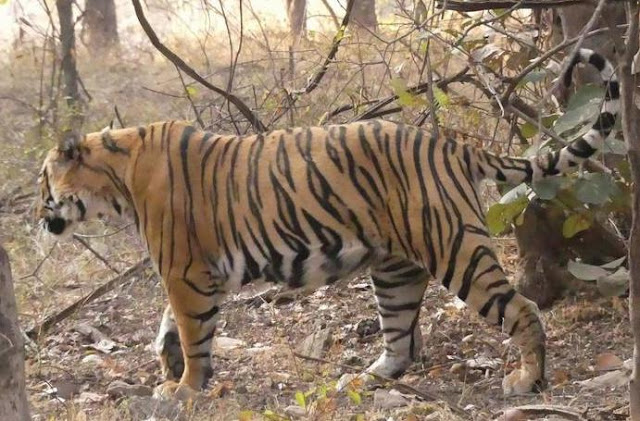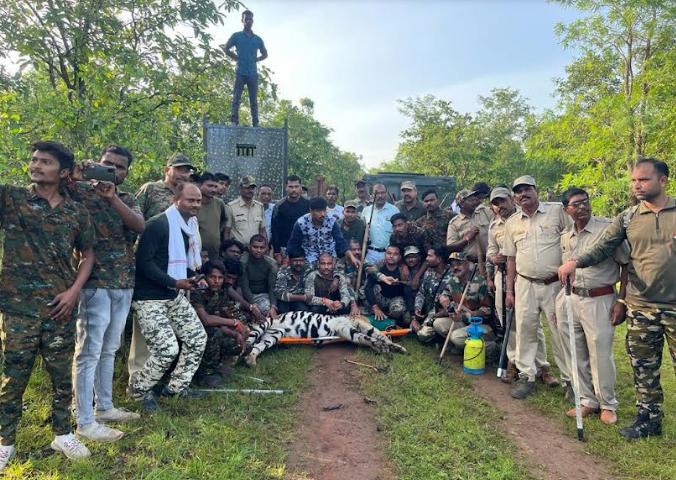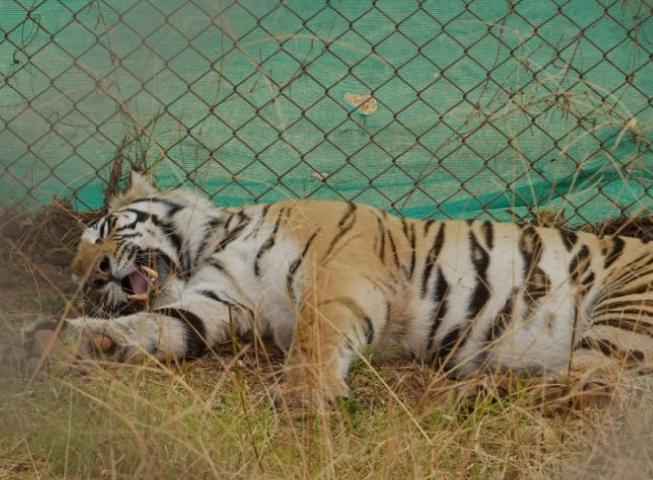Increasing incidents of tiger human conflict is leading to more and more tigers behind bars. Accused of killing three people, a tiger from Ranthambore national park was finally sent to a cage which would be his house for the rest of his life. Another tiger was caught near Tadoba national park and sent to a transit treatment centre where the animal awaits a punishment as a State Committee forest department began a ‘trial’. Hope the committee takes an early decision on the tiger.
T104, The Great Escaper
T-104 or Chikoo or Hammir , a ferocious tiger of Ranthambore was housed for three years in a 5 -bigha or over 3 hectare enclosure in the core area of Ranthambore national park for the past three years. The big cat was fed by the park management while it remained inside the enclosure . But the location where Chikoo was housed is a tiger corridor and as and when some tiger crosses, a fight took place- between the wild tiger outside the enclosure and Chikoo inside the iron grills. This would often lead to injuries to both. In 2019, when T- 104 was tranquilized and caught, the state forest department was not able to make a decision abput the tiger's future . Now they have decided to send the animal in a cage to Mukundara tiger reserve near Kota city of Rajasthan.Named after Hammiradeva, the last Chauhan ruler of Ranthambore, T-104, alias Chikoo’ alias ‘Hammir’, will be the second tiger to be caged for life after ‘Ustad’ or T24, whose capture and subsequent captivity in 2015 had set off a wave of protests on social media in India and abroad.
Also read: Rising Tiger Numbers Midst Shrinking Forest Cover Makes No Sense
In T-104's case, conservationists recommend sending the tiger to a zoo or rescuing centre with proper veterinary services and handlers of captive animals. T-104 gained notoriety in 2019 when he killed three people in and around Ranthambore in the Sawai Madhopur and Karauli districts. The first victim was a woman who had gone to defecate in a field near her house in the wee hours just before dawn. The tiger was tranquilised that very day, radio-collared and released him in the core area of the reserve. But the tiger got rid of the collar and moved out of the core area to reach the same village where he was tranquilised and caught. He was captured again and sent to the park but he escaped again. Later T-104 killed two more people before he was caught and brought to the 5-bigha -open Ranthambore enclosure.
T103: Case Of Mistaken Identity
About 500 kms away from Ranthambore near famous Tadoba tiger reserve, Brahmpuri region has become major man- animal conflict zone. Situated on the edge of Tadoba Andhari Tiger Reserve (TATR) amidst fragmented forests area , 5 lakh villagers jostle for space with 100 tiger resulting everyday day conflict with the animal. Most of the cases of the confrontation take place when the villagers go inside the forest to pick fuelwood or for grazing. Open defecation in the forest also lead to incidents. On August 19, 2022, the Rapid Response Unit (RRU) of TATR tranquilized and captured “T-103_SAM-1,the dreaded tiger of North Bramhapuri forest range” that had allegedly killed three people " including two in the same month. After tranquilization, animal was taken to Transit Treatment Center at Chandrapur .From here, it would be transferred to Gorewada wildlife rescue centre in Nagpur.
Also read: Delay In Cheetah Translocation, Indian Bureaucrats in Tizzy
“ A state committee of the forest department would decide whether the tiger needs to be transferred to the rescue centre which has a zoo also or will be released in the wild. “ It is a sort of trial”, a department official in Nagpur said. The officials said that that the tiger was found deep in human habitation where three people were killed by a tiger , not sure whether the same tiger or not". That day this was tranquilised because it was found deep in the human habitation . There are three more tigers there. Had the tiger not been captured, there would have been risk of his life from the villagers”, officials said. This also means that the conflict will continue because if the presence of more tigers in the region. It also means that more tigers are likely to be moved in cages in Brahmpuri in the future.
Serving Lifer: Sundari Is Victim Of Officials' Apathy
Hope the officials in Maharashtra will take some lessons from the case of Sundari, a tigress relocated from Madhya Pradesh to Odisha as a part of the first interstate tiger relocation programme in June 2018, and take an early decision on T-103. Sundari was translocated from Bandhavgarh national park to Satkosia tiger reserve of Odisha. A male tiger –Mahaveer- was also brought from Kanha national park as a tiger reintroduction programme in Satlosia. Mahaveer died ( poached) while Sundari was involved in conflict with the local villagers ,not willing to accept the presence of the tiger . After months of conflict, the tigress was captured and sent to a cage where she lived for a long period. She also became used to human presence as she was fed by handlers inside the cage.
Also read: Tigress Gets ‘Life Imprisonment’
After prolonged captivity, she also lost the wild hunting skills and the chances of the tigress going back to the wild became dim. Finally in March 2022 , the authorities decided to sent the tigress to prison, a small enclosure in VanVihar national park, an open zoo cum rescue centre in Bhopal. Officials said that “ she cannot be released in wild as she was accustomed to humanpresence and developed a tendency of approaching towards humans ”. Hope the state committee in Nagpur will take an early decision in the case of T-103-SAM-1 to prevent ‘life imprisonment’ of another tiger.
Cover Image Courtsey Ranthambore national park





Comments
Post a Comment